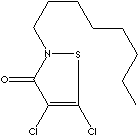PRODUCT IDENTIFICATION

H.S. CODE
TOXICITY
CLASSIFICATION
PHYSICAL AND CHEMICAL PROPERTIES
Clear to yellow liquid
soluble
AUTOIGNITION
NFPA RATINGS
REFRACTIVE INDEX
Stable under ordinary conditions. Light sensitive
APPLICATIONS
The list of isothiazolinones include;
|
Material |
CAS # |
EINECS # |
| (4-Chlorobenzyl)-3(2H)-isothiazolone | 26530-09-6 |
|
| 1,2-Benzisothiazolin-3-one | 2634-33-5 | 220-120-9 |
| 2-Butyl-1,2-benzisothiazolin-3-one | 4299-07-4 |
|
| 2-Methyl-4,5-trimethylene-4-isothiazolin-3-one | 82633-79-2 |
|
| 2-Methyl-4-isothiazolin-3-one | 2682-20-4 | 220-239-6 |
| 2-Methyl-3-isothiazolone hydrochloride | 26172-54-3 |
247-499-3 |
| 2-Octyl-3(2H)-isothiazolone | 26530-20-1 | 247-761-7 |
| 4,5-Dichloro-2-cyclohexyl-4-isothiazolin-3-one | 57063-29-3 |
|
| 4,5-Dichloro-2-octyl-3(2H)-isothiazolone | 64359-81-5 | 264-843-8 |
| 4-Chloro-2-octyl-3(2H)-isothiazolone | 64359-80-4 | 264-842-2 |
| 5-Chloro-2-(4-chlorophenylmethyl)-3(2H)-isothiazolone | 66159-95-3 |
|
| 5-Chloro-2-methyl-4-isothiazolin-3-one | 26172-55-4 | 247-500-7 |
| 5-Chloro-2-methyl-3(2H)-isothiazolone, calcium chloride complex | 57373-19-0 |
|
5-Chloro-2-methyl-2H-isothiazol-3-one hydrochloride |
26530-03-0 |
247-760-1 |
| 2-Methyl-4-isothiazolin-3-one calcium chloride | 57373-20-3 |
|
Mixtures of these materials |
|
|
Common biocides ( antiseptic agents, preservatives, bactericides, slimicides, fungicides) in cosmetics are parabens, isothiazolones, formaldehyde and formaldehyde releasing substances such as quaternium 15, diazolidinyl urea.
10% SOLUTION (MIXTURE)
APPEARANCE
Clear to yellow liquid
ACTIVE CONTENT
10.0% min
pH
3 - 5
Hexachlorophene and Benzalkonium Chloride are used primarily in hand or face washes. Benzalkonium Chloride must not be applied to areas which have not been fully rinsed as it is inactivated by organic compounds. Benzalkonium application many include disinfecting instruments and preservativing drugs in low concentration form.
Iodine compounds have the widest spectrum of antiinfectives against bacteria, fungi, spores, protozoa, viruses, and yeasts. Aqueous iodine are less effective than alcoholic solutions, but alcoholic component is drying and irritating to abraided skin. Povidone iodine is convenient to use as it is less irritating, but not as effective.
Chlorhexidine is used as a safe antiseptic or disinfectant to apply to prevent body infection and in oral rinses for treating sore gums and mouth ulcers and preventing plaque on teeth. It is used in the form of acetate, gluconate or hydrochloride, either alone or in combination with others such as cetrimide.
Cetrimide is an antiseptic agent with detergent properties. It has the wide spectrum of antiinfectives against bacteria and fungi. It is used as an ingredient of shampoos for treating seborrhoea and psoriasis. A very dilute solution can be applied topically for the relief of sore gums.
Hippuric Acid, an amino acid glycine, is excreted from the body and is used in urinary system drugs. Hexamine hippurates is helpful for preventing and treating infections of the urinary system; it acts by being transformed to formaldehyde.
Triclosan is a very popular antibacterial agent. It is used in hospitals for cleansing and disinfecting the skin of patients and surgeons. It is used in cosmetics, household goods and personal care products. It is also used in plastics and textiles for antibacterial activity purpose.
Cetylpyridinium chloride is used in oral rinses for cleaning mouth and treating minor throat or mouth infections and teething problems.
Dequalinium chloride is antiinfectives against bacteria and fungi. It is used in treating bacterial or fungal infections of mouth and throat.
PRICE INFORMATION